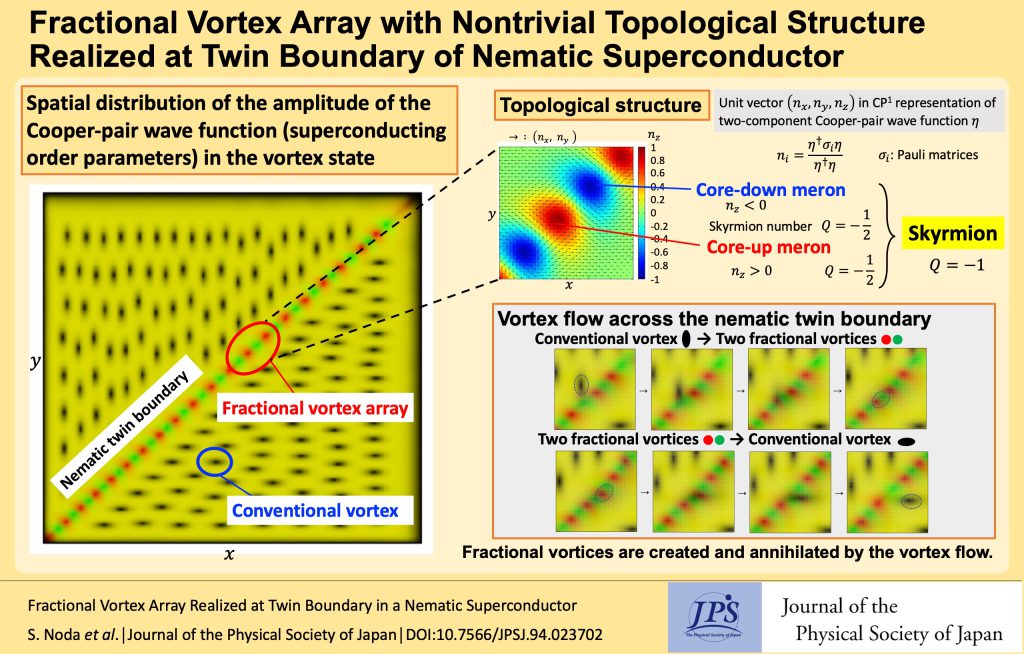Fractional Vortex Array with Nontrivial Topological Structure Realized at Twin Boundary of Nematic Superconductor
© The Physical Society of Japan
This article is on
J. Phys. Soc. Jpn.
94,
023702
(2025)
.
Analysis of the two-component Ginzburg-Landau theory suggests that a conventional vortex is transformed into two fractional vortices with the topological nature of core-down and core-up merons at the twin boundary of a nematic superconductor.

Nematics represent an orientational order in an otherwise isotropic material, and the two-fold nematic electronic state in iron-based superconductor FeSe has been investigated extensively. The superconducting state possesses a two-fold nematic order, with the superconducting gap described by a combination of two-component order parameters (Cooper-pair wave functions) comprising s- and d-waves. In the nematic electronic state, a nematic twin boundary appears parallel to the (110) direction between the two domains, with a nematic orientation along either the a- or b-axis. The nematic superconducting state in each domain is modeled as an s+d or s-d wave state, and a time-reversal symmetry-breaking s+id wave state is suggested to appear locally at the nematic twin boundary.
In this study, we theoretically investigate the spatial structure of vortex states in the presence of a nematic twin boundary using the two-component time-dependent Ginzburg–Landau (TDGL) theory as a model of nematic superconductor FeSe. First, we successfully reproduced the experimental observation that the orientation of the nematic vortex-core elongation rotated by 90°across the twin boundary. In a conventional nematic vortex with one flux quantum, the s- and d-wave order parameters have a vortex core at the same position. Next, we discovered that a fractional vortex array appeared at the nematic twin boundary, where the appearance of the fractional vortex array is caused by the unbinding of vortex cores between the s- and d-wave order parameters. To clarify the topological structure, we analyzed the corresponding unit vector in the CP1 representation of the two-component superconducting order parameter and estimated the skyrmion numbers. We observed an intriguing spatial pattern of fractional vortices exhibiting a nontrivial topological structure as a pair of core-down and core-up merons that form a skyrmion.
The exotic fractional vortex states can be confirmed by observing the time evolution of the vortex-flow process, in which a conventional vortex core is separated into two fractional vortices at the nematic twin boundary. We examined the vortex-flow process across a nematic twin boundary under a supercurrent parallel to the twin boundary. In our TDGL simulation, we observed that a conventional vortex core was trapped at the twin boundary and separated into two fractional vortices. Conversely, when leaving the twin boundary, the two fractional vortices merged into one conventional vortex.
These results indicate that the twin boundary of nematic superconductors may be a promising platform for future experimental and theoretical studies pertaining to fractional vortices with nontrivial topological structures of merons and skyrmions in multicomponent superconductors.
(Written by S. Noda, H. Adachi, and M. Ichioka.)
J. Phys. Soc. Jpn.
94,
023702
(2025)
.
Share this topic
Fields
Related Articles
-
Exploring the Vibrant Interplay of Machine Learning and Physics
Cross-disciplinary physics and related areas of science and technology
Electron states in condensed matter
Elementary particles, fields, and strings
Mathematical methods, classical and quantum physics, relativity, gravitation, numerical simulation, computational modeling
Statistical physics and thermodynamics
Superconductivity
2025-3-13
This Journal of the Physical Society of Japan Special Topics edition explores how physics and machine learning complement each other and can solve unresolved problems in physics.
-
Single-Crystal Growth of a Cuprate Superconductor with the Highest Critical Temperature
Superconductivity
2024-5-20
Millimeter-sized single crystals of a trilayer cuprate superconductor (Hg,Re)Ba2Ca2Cu3O8+δ that exhibits the highest superconducting transition temperature under ambient pressure, were grown reproducibly and safely.
-
The Mysterious Superconductivity of Sr2RuO4
Superconductivity
2024-8-22
Researchers review the recent advancements made towards solving the mysteries of the unconventional superconductivity of Sr2RuO4, analyzing recent experiments and theoretical models and proposing approaches to resolve current challenges.
-
Discovery of Unconventional Pressure-Induced Superconductivity in CrAs
Electronic transport in condensed matter
Superconductivity
2024-8-13
A new study has discovered pressure-induced superconductivity in the helimagnet CrAs, originating in the vicinity of the helimagnetic ordering, representing the first example of superconductivity in Cr-based magnetic systems.
-
Microscopic Exploration of Electronic States in Nickelate Superconductors
Magnetic properties in condensed matter
Superconductivity
2024-5-31
The multilayered nickelates, La3Ni2O7 and La4Ni3O10 , were investigated using nuclear magnetic resonance (NMR) at ambient pressure. Metallic electronic states under the density wave order were observed microscopically for both compounds.




